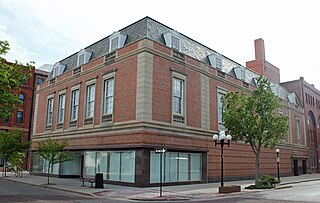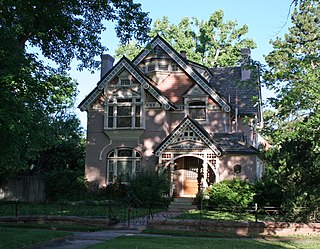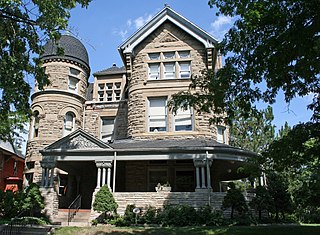
Drumthwacket is the official residence of the governor of New Jersey. The mansion is located at 354 Stockton Street in Princeton, near the state capital of Trenton. It is one of only four official governor's residences in the country not located within their respective state capitals; the others are in Wisconsin, Ohio and Tennessee.

The Historic Third Ward is a historic warehouse district located in downtown Milwaukee, Wisconsin. This Milwaukee neighborhood is listed on the National Register of Historic Places. Today, the Third Ward is home to over 450 businesses and maintains a strong position within the retail and professional service community in Milwaukee as a showcase of a mixed-use district. The neighborhood's renaissance is anchored by many specialty shops, restaurants, art galleries and theatre groups, creative businesses and condos. It is home to the Milwaukee Institute of Art and Design (MIAD), and the Broadway Theatre Center. The Ward is adjacent to the Henry Maier Festival Park, home to Summerfest. The neighborhood is bounded by the Milwaukee River to the west and south, E. Clybourn Street to the north, and Lake Michigan to the east.

The Loveland Block and the Coors Building are adjacent historic storefront buildings in downtown Golden, Colorado. The Loveland Block, named for pioneer William A.H. Loveland, once served as the territorial capitol building of Colorado. Both buildings are listed on the National Register of Historic Places as a single entity.

The Montgomery Ward Building is a historic department store building in downtown Pueblo, Colorado. It was listed on the National Register of Historic Places in 1996. Currently used as an office building, it houses the American Bank of Commerce, the Colorado Lottery, and the Pueblo Work Force Center. Previously it was occupied by QualMed as its headquarters.

The Henkel-Duke Mercantile Company Warehouse, also known as Charles Henkel & Co. Building or Montgomery Ward Warehouse, is a historic warehouse in downtown Pueblo, Colorado. The building once served as a wholesale grocery warehouse.

The Nathaniel Winsor Jr. House is a historic house located at 479 Washington Street Duxbury, Massachusetts. It currently serves as the headquarters of the Duxbury Rural and Historical Society.

The Charles H. Stickney House in Pueblo, Colorado, USA, was built in 1890. It was designed by New York architect William Halsey Wood, and Pueblo architect Frederick Albert Hale supervised its construction.

The Fidelity Building is an office building in Knoxville, Tennessee, United States. Initially constructed in 1871 for the wholesale firm Cowan, McClung and Company, the building underwent an exterior renovation and was converted to Fidelity-Bankers Trust Company in 1929 and has since been renovated for use as office space. In 1984, the building was added to the National Register of Historic Places for its architecture and its role in Knoxville's late-nineteenth century wholesaling industry.

The Frederick W. Neef House is a house in Denver, Colorado, United States that was built in 1886 and is listed on the U.S. National Register of Historic Places.

The Iddings Block is a property in Grand Forks, North Dakota that was listed on the National Register of Historic Places in 1982. It was one of 13 new commercial business block buildings built in Grand Forks in 1892, and is one of just two surviving from the 1888-1892 era. During 1892 to approximately 1906-1909, it was the location of Iddings and Company, the largest bookstore and stationer in the state in that period. In 1981, it housed Ruettell's.

Grand Forks Mercantile Company is a property in Grand Forks, North Dakota that was listed on the National Register of Historic Places in 1982. Built in 1893, the building includes Early Commercial and Italianate architecture.

William A. Lang (1846–1897) was an architect active in Denver, Colorado from 1885 to 1893. On his own or in partnership he designed a number of buildings that survive and are listed on the U.S. National Register of Historic Places. Lang partnered with Marshall Pugh to form Lang & Pugh in 1889. The firm also employed Reinhard Schuetze for a time.
Frederick Albert Hale was an American architect who practiced in states including Colorado, Utah, and Wyoming. According to a 1977 NRHP nomination for the Keith-O'Brien Building in Salt Lake City, "Hale worked mostly in the classical styles and seemed equally adept at Beaux-Arts Classicism, Neo-Classical Revival or Georgian Revival." He also employed Shingle and Queen Anne styles for several residential structures. A number of his works are listed on the U.S. National Register of Historic Places.
Alfred Lovering Tubbs (1827-1896) was a pioneering entrepreneur who founded Chateau Montelena Winery in Calistoga, California.

The Rosemount Museum, pronounced "Rosemont" is a historic house museum in Pueblo, Colorado, it is situated on a square block at the corner of one of the highest points in north Pueblo and across the street from Parkview Medical Center. It is a 24,000-square-foot, three story mansion with attic and basement and contains thirty-seven rooms. It was begun in 1891 and completed in 1893 for John A. Thatcher and his family. A 6,000-square-foot carriage house was also built on the property.














